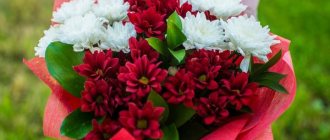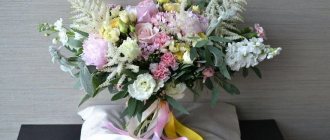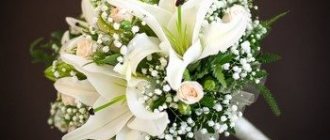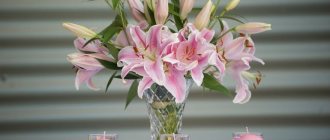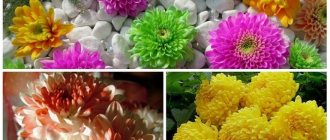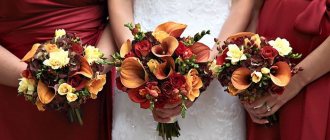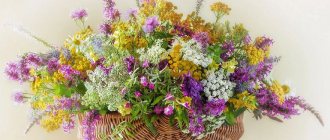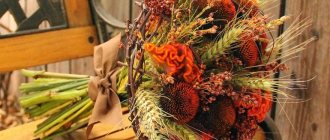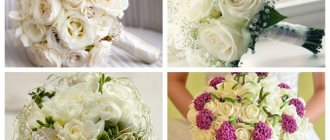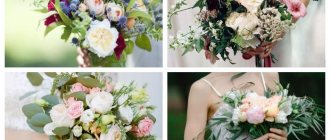Some people think that floristry is a simple activity that anyone can learn. Others believe that natural or artificial floristry is an impossible task for an ordinary person who does not have the proper knowledge, skills, artistic taste and creative thinking. In fact, both the first and second statements are true.
Floristry is the decorative and applied art of assembling various flower arrangements, which has its own technical and creative side. This means that anyone can truly learn, especially if they have the desire. Therefore, if the birthday of your beloved friend, mother is approaching, or if roses have simply bloomed in the garden, do not put off your first lesson and try to collect a bouquet yourself. Simple and clear recommendations from an experienced florist will help with this.
Information: The main task of floristry is to provide floral decoration for interiors, outfits, cars for a holiday, compiling everyday compositions for work, commercial and residential premises, as well as assembling bouquets of various types and purposes. In addition, the florist can create accessories from flowers - frames, arches, garlands, baskets, handbags and even necklaces with bracelets.
Compatibility
The proximity of some colors is absolutely detrimental to each other, but some tandems of “quarrelsome” neighbors turn out to be mutually beneficial.
Negative combinations:
- forget-me-not tulips;
- narcissus lilies of the valley;
- lilac-violets;
- carnations-roses;
- cornflower lilies;
- poppies-lilies.
Positive tandems:
- Chrysanthemums, peonies, asters, and dahlias are suitable for carnations;
- lilies get along well in bouquets with phlox, irises, and chamomile;
- The chrysanthemum is suitable for the neighborhood of dahlias, gerberas, nasturtiums;
- tulips feel comfortable next to gypsophila, calla lilies, and hydrangea;
- freesias remain fresh longer in a vase with hyacinths, tulips, and irises.
Zinnias - cute flowers for September 1
bouketsvoimirukami.ru
Elegant zinnias belong to the Asteraceae family and are smaller in size than their relatives, asters. Such flowers will appeal not only to teachers, but also to the children themselves! Zinnias stand well when cut, but if they are slightly wilted, trim the ends of the stems, then put them in hot water for 15 seconds and in ice water for 10 minutes. Then place it in a vase with water at room temperature. It is better to combine zinnias with roses, carnations, asters, and dahlias.
A round bouquet of zinnias, ageratums and country greens looks fresh and unconventional. Try making it simply without packaging, and if desired, stick a few simple pencils into the composition. Photo source: 7dach. ru
What colors does chrysanthemum go with?
Before making a bouquet and selecting options, it is worth deciding which varieties of chrysanthemum will be used. If these are plants with small flowers, you can use them to create a simple mono-bouquet, or use them as an addition. For example, several branches can be added to a bouquet with roses or gerberas. But you shouldn’t use them in compositions with lilies of the valley or tulips; in such a combination, chrysanthemums look rude and inappropriate.
If we are talking about large and voluminous flowers, then they often act as the basis of the bouquet, and other plants only emphasize their airiness and beauty. Chrysanthemum will look good next to such neighbors as:
eustoma;
alstroemeria;
hydrangea;
chamomile;
iris.
You should not combine chrysanthemums and exotic orchids or callas in one bouquet. These flowers are so different that finding the right combination is difficult even for an experienced florist. Also, you don’t need to use more than 2-3 plants in a bouquet. It is better to give the composition volume and expressiveness by choosing flowers of the same variety, but of different shapes and sizes, and also by adding decorative greenery.
What to combine with
It’s not difficult to assemble a mono-bouquet of chrysanthemums with your own hands, but to effectively combine them with other types of plants you will need a delicate taste and basic knowledge of floristry. It is in such “tandems” that the autumn beauty looks best.
The following combinations are considered optimal:
- With roses. Here it is better to choose a spherical bouquet arrangement so that all components are clearly visible. The color scheme can be both nuanced and contrasting. You can complicate the ensemble by adding ranunculus, freesia or snowberry twigs. Sometimes peony roses are used instead of ordinary roses - the result is a very delicate, fresh combination.
- With alstroemeria. In this case, you need to use only large single-headed buds of spherical or curly varieties, playing on the difference in flower shapes and textures. Garden daisies and ferns will complete the composition.
- With gerberas. An excellent “duet” in a classic style. Bright, colorful and positive.
- With hydrangea. Another unusual and stylish combination. Large “Spider” chrysanthemums with long, widely spread petals, reminiscent of spider legs, and lush hydrangea inflorescences look very colorful together. They will be the best decoration for a retro-style wedding.
Spectacular cannas for a school bouquet
Large perennial cannas are not so often found in summer cottages. And on school lines these flowers are quite a curiosity. Therefore, if you want something original and festive, Cannes is your option. Just don’t make such a bouquet for a junior high school student, because... It will be difficult for him to hold the thick stems of the plant in his hands for several hours. Cut cannas when the flowers are half open. Flowers will last in water for up to 8 days.
ok.ru
Large canna leaves and flowers will look luxurious without any additions. Or you can use, for example, only leaves or several flowers on thick stems. Cannes will be a wonderful gift for a physical education teacher, labor teacher or male director.
Such a bouquet does not need any special design and does not require decorations. But you can supplement the composition with dry or fresh twigs.
Composing a composition
Chrysanthemums feel great in a mono bouquet. Add a couple of fern branches or other greenery to them - and the composition is ready. They can also be combined with dried flowers, berries and pine cones, depending on the season and style of the holiday. Compositions using chamomile chrysanthemum with a butterfly of a certain shade look especially good. And these imperial flowers can harmonize with many others and create unique compositions.
A set of chrysanthemums and gerberas will be an excellent option for a wedding bouquet. The union of these colors is amazing. They complement each other perfectly. They have a wide palette of shades, which is convenient when combining them with the bride’s accessories to create the perfect look.
A composition of roses and chrysanthemums is a classic that will suit any newlywed look. Young, petite girls should choose small wedding flowers. And the bouquet itself is spherical or hemispherical in shape. Large chrysanthemums are more suitable for tall and stately ladies.
A bridal bouquet of chrysanthemums and alstroemerias looks elegant and romantic. Although alstroemeria flowers are very fragile and delicate, they have proven themselves to be excellent. They will withstand a wedding celebration and last a long time after. The unusualness of the flower is that it combines the best of lilies and orchids. In a composition of bush chrysanthemums, it will not get lost, but, on the contrary, will reveal its beauty.
Having chosen a unique composition, it is also important to take care of the boutonniere for the groom. It should be a mini-copy of the bouquet, its continuation
Lush buds look great on the broad chest of a young man and will not lose their presentable appearance throughout the entire wedding day.
You can make a wedding bouquet with your own hands. The main thing is to follow some simple rules, and the composition will withstand all the vicissitudes of the gala day and evening. And then it will remain in the water for a long time, delighting with its appearance. Using the master class, you can quickly learn how to form bouquets
After all, it is important not only to choose beautiful and high-quality flowers, but also to know how to assemble them correctly so that they do not fall apart and maintain a presentable appearance. So, to arrange a wedding arrangement of chrysanthemums and roses, you need to perform the following sequential steps:
- First you need to select the best quality specimens. Also choose appropriate shades.
- If there are thorns on the stems, they need to be removed, cut off the lower leaves, leaving only the upper ones.
- The flowers are laid out on the table, their stems are cut to the same length.
- The set can be supplemented with fern leaves, various berries or dried flowers.
- Having 6 branches of charcoal white chrysanthemums and 3 branches of pink roses in your arsenal, you can put together an excellent composition.
- Flowers are collected in a circle, roses should be between chrysanthemums. Moreover, the first ones are slightly higher than the second ones.
- The stems are tied with twine. Next, the bouquet is decorated to taste. You can wrap it with ribbon or wrap it in a nice wrapper.
The dream of any bride is a wedding bouquet of chrysanthemums. So beautiful, stylish and at the same time simple. With its own history and magical power.
Possible options
Almost any bouquet can be made from chrysanthemums; they are universal due to their diversity. Their beauty is clearly revealed in classic dome-shaped bouquets. To create such a composition, you can use small flowers of the Dune or Altyn Ai varieties; the bouquet will be very elegant and simple at the same time. The florist can also offer options such as:
- Round bouquet. Using a special base, a ball is assembled from flowers; the plants are selected in such a way that the composition is uniform, without protruding branches and leaves. Mostly flowers of the same shade and shape are used, but exceptions are possible.
- Cascading bouquet. A relatively new trend in wedding floristry, such compositions, although quite bulky, look very luxurious. At the base are several large inflorescences, from which long stems of exotic greenery, branches of orchids or other climbing flowers cascade down. You can combine different plants, the main requirement is that the stems must be sufficiently flexible and strong. Bush chrysanthemums are perfect for this.
- “Dishesive” bouquet. In such a composition, flowers are gathered as if hastily, individual branches or leaves are knocked out of the general row. To enhance the effect, deliberately rough materials are used as decoration: ropes, burlap.
An experienced specialist will suggest an option that suits both the bride’s image and the theme of the wedding. When choosing a bouquet, the florist will take into account a variety of factors: the girl’s appearance, the design of the dress, the bride’s preferences.
How to make a bridal bouquet from chrysanthemums
Wedding floristry is an important component in creating the bride's image. Bouquets are made from a variety of types of flowers, ranging from field daisies to exotic varieties of orchids. One of the favorites of holiday compositions are chrysanthemums.
Chrysanthemum is often called the “queen of autumn” - it is cold, noble and attractive in its restrained beauty. Combining the bright notes of summer, the softness of autumn coolness and the ringing snowiness of winter, it fits perfectly into any picture of nature. Translated from Greek, its name means “golden flower,” and this phrase perfectly suits the description of chrysanthemum.
There are many varieties of chrysanthemums, differing not only in color, but also in the shape of the color itself: flat, terry, thread-like, simple, curly, and so on. Usually teardrop-shaped or spherical bouquets are made, and you can also often find compositions on a porta bouquet.
Who do they give chrysanthemums to?
These flowers, even when cut, retain their beauty and attractiveness for a long time, so they are given as a gift in any season of the year, even in winter. There will be reasons for this, since there are always many events in the life of every person. A bouquet of chrysanthemums for a birthday, anniversary, wedding, ceremony always looks perfect. The bride will be delighted with a bouquet with small white or cream chrysanthemums. Large flowers will delight your wife, because they are presented with love and tenderness. A mature woman in a high position will admire cherry and burgundy chrysanthemums. She will definitely like red flowers with a wine tint.
Language of color
Why use words when you can express your feelings and emotions with a bouquet? And the form here plays far from the main role. It's all about the combination of colors - they serve as an indicator of mood and set the tone for the entire holiday. The predominance of any shades in the composition may mean the following:
- Pink - tenderness and romance;
- Blue/blue - fun, joy, optimism;
- White - innocence, fragility, sincerity;
- Red - passion, energy, expression;
- Yellow - trust, calm, warmth;
- Lilac - rebellion, character, charisma.
If the wedding theme requires the use of a specific color, but it is not currently on sale, then chrysanthemums can be painted with a special paint. But in this case, you need to remember that they won’t last long after the “execution.”
It is also worth considering the bride’s color type. For example, bouquets made of flowers in pastel shades: pastel pink, cream, peach are suitable for blondes. Brunettes will look bright and contrasting against the background of compositions of red, lilac, and orange flowers. And red-haired girls look great in the company of yellow and green chrysanthemums.
Bridal bouquet of roses - master class
To make such a composition, take:
- 20 roses;
- three gypsophila;
- 70 cm satin ribbon;
- regular tape;
- Double-sided tape;
- floral wire;
- scissors;
- stationery knife;
- porta bouquet with oasis.
Using a knife, you need to clear the stems of leaves and thorns. Cut them so that they are equal in length to the handle of the portaquet holder.
Place double-sided tape on the handle of the bouquet and attach the stems here. Place the next row of stems on the table and secure them in this position with ordinary tape.
Cover the top of the bouquet with double-sided tape and glue the roses here, placing the next row in a checkerboard pattern.
Now place the prepared stems on the “leg” of this device and glue them here with tape.
Wrap the resulting leg with a wide satin ribbon and tie a bow.
Dip a floral sponge, called an oasis, into water to saturate the element. Now you can insert the sponge into the hole prepared for it and cover it with a plastic semicircle on top.
Cut the buds, leaving a 5 cm long stem on each. Stick them into the oasis, starting from the middle.
When there are enough roses, stick gypsophila into the sponge.
This is what a beautiful bride's bouquet, created with your own hands, can turn out to be.
Ranunculus look like little roses, so these flowers go together wonderfully. See how to make this type of bridal bouquet.
Take:
- 15 ranunculus;
- three matthiols;
- 15 roses;
- three branches of rhododendron;
- three branches of eucalyptus;
- pruner;
- two large vases;
- tape;
- wire;
- 5 pins with beads;
- satin ribbons;
- lace braid.
For now we will only need the blossomed ranunculus buds. They need to be placed in water so that they are saturated with it.
Do not throw away the stems, string them on a wire.
Take a eucalyptus branch, attach a rhododendron and a whole ranunculus flower to it. Attach three roses to this base. Then add the rest of the flowers. Wrap the stems with tape, and attach a decorative ribbon on top of it and secure its ends with pins.
You will get a wonderful bouquet for the bride from roses and other flowers.
Speaking about how to make a bouquet for the bride from peonies, it should be noted that there are varieties of roses similar to these flowers. Look how harmonious the next bridal bouquet looks.
You can make it your own if you take:
- peonies;
- roses;
- carnations;
- matching satin ribbons;
- scissors;
- pruner
Place smaller flowers between large ones and give the bouquet a spherical shape. Trim the stems, cut off the excess and wrap them with lace braid. Tie a satin bow over it.
Such a bouquet for the newlywed will look great together with the groom’s boutonniere if these compositions are made in the same style. You will make a boutonniere if you combine a large peony and rose bud. Tie the stems of these plants with a pretty ribbon.
If you like the delicacy of orchids, then check out how to make an arrangement with them.
Take:
- 5 orchids;
- three ostrich feathers;
- three branches of salal;
- tape;
- lace fabric;
- five elongated floral flasks;
- thin wire;
- coconut fiber;
- six skewers;
- scissors;
- plastic floral tape;
- pruner;
- stapler;
- knife.
Fill the flasks with water and cover them with lids. Wrap the outside of these containers with coconut fiber and secure it with wire.
Trim the orchids and place them in flasks.
Also trim off the excess from the ostrich feathers and use tape to glue them onto the skewers.
Cut the plastic ribbon in half so that you get two half a meter long. Attach trimmed feathers to the edges of the plastic strips using wire.
Now combine them with the prepared orchids and attach salal branches to this base. Secure the composition with tape.
Additionally, secure the stems with plastic tape.
Take a rectangle of lace, wrap it around the resulting composition and wrap it with a ribbon. Your masterpiece will have a light, airy, openwork look.
And if you want to make a bouquet so that it does not wilt, then check out another master class.
Chrysanthemums and wedding
Fresh flowers can transform any holiday into a fairy tale. No wedding is complete without flowers. In combination with tenderness, romance, purity, florists pursue the idea of creating luxury and celebration.
Against the general background of the availability of any flower arrangement, a bouquet of chrysanthemums does not lose its relevance. They are harmoniously placed around the perimeter of the room, as well as on guest tables.
Chrysanthemum rightfully takes its place of honor - the attractiveness and freshness of the flower are preserved for a very long time. The lightness and airiness of the flower are reminiscent of the legend that it symbolizes eternal youth and beauty.
Be that as it may, we are dealing with a cut plant. To make a bouquet of chrysanthemums last longer, you need to follow the rules:
- flowers should be broken rather than cut;
- if a cut is unavoidable, it should be at an oblique angle. This can be easily done with pointed pruning shears.
From a flower that has bloomed three-quarters, shoots are removed, leaving up to three to four leaves below. The procedure is performed in the morning or evening. When immersing a bouquet of chrysanthemums in water (photos of which you see in our article), throw an aspirin tablet or a pinch of salt into the container.
Water should not exceed half the length of the stems. Where the water is chlorinated, it is advisable to take the settled liquid. Some people resort to this trick: they add a little solution of potassium permanganate or lapis to the water.
Monobouquet
Thanks to the successful work of domestic and foreign breeders, several tens of thousands of varieties of chrysanthemums have been bred, which differ in stem height, bud diameter and, of course, color.
Such a variety of choices opens up unlimited possibilities for beginners and professional florists when composing flower arrangements involving this decorative crop. Small double flowers or large buds, monochrome, contrasting or multi-colored, long or short branches - there are many options for designing mono-bouquets of chrysanthemums.
Language of color
Why use words when you can express your feelings and emotions with a bouquet? And the form here plays far from the main role. It's all about the combination of colors - they serve as an indicator of mood and set the tone for the entire holiday. The predominance of any shades in the composition may mean the following:
- Pink - tenderness and romance;
- Blue/blue - fun, joy, optimism;
- White - innocence, fragility, sincerity;
- Red - passion, energy, expression;
- Yellow - trust, calm, warmth;
- Lilac - rebellion, character, charisma.
If the wedding theme requires the use of a specific color, but it is not currently on sale, then chrysanthemums can be painted with a special paint. But in this case, you need to remember that they won’t last long after the “execution.”
It is also worth considering the bride’s color type. For example, bouquets made of flowers in pastel shades: pastel pink, cream, peach are suitable for blondes. Brunettes will look bright and contrasting against the background of compositions of red, lilac, and orange flowers. And red-haired girls look great in the company of yellow and green chrysanthemums.
Flower symbolism
To the Japanese, the “queen of autumn flora” resembles the sun. According to popular belief, it brings happiness, prosperity and longevity, and if plucked on September 9, it can even give immortality. Among eastern peoples, white flowers are considered a strong wedding amulet, protecting against envy and unkind thoughts.
Presented as a gift, chrysanthemums testify to the noble intentions, strength and sincerity of the feelings of the giver, and embody the wish of success and prosperity to the recipient. In this case, yellow flowers can and should be given to your beloved girl as an expression of tenderness and love. And the crimson-red buds will tell about the passion raging in the heart.
Friends, parents and males - for example, a boss or work colleague - are advised to choose “emperor flowers” in violet, lilac and orange shades. They symbolize wealth and prosperity.
Chrysanthemums as a gift
You can give chrysanthemums both on your birthday and on other holidays. Such a gift can express your deepest feelings for a person, telling about them in the rich language of floristry. It will be useful for men who are planning to present their beloved with a composition of these magical flowers to familiarize themselves with its basics.
In the East, chrysanthemums represent an inexhaustible source of energy and serve as raw materials for the manufacture of medicines, as well as anti-aging skin care products. According to ancient belief, a glass of wine with a petal of a sunny flower dipped into it will bring immortality to the drinker. Therefore, by presenting a bouquet of them, the donor thereby wishes the birthday boy good health and longevity. It is also necessary to recall that the color of the flower is no less important.
- White chrysanthemums are a symbol of purity, fidelity and truth. By purchasing these for the hero of the day, you will pay tribute to his high moral qualities.
- Lilac and violet will tell your best friend how valuable she is to you.
- Oddly enough, yellow chrysanthemums, unlike other colors of this color scheme, have only a positive meaning. Florists use them in their compositions, knowing about the man’s intention to confess his love to his half. Trembling feelings, boundless trust and the desire to be with your beloved always - this is the meaning of yellow chrysanthemums.
An alternative to a bouquet or ikebana of cut flowers will be indoor chrysanthemums in pots. Their growing popularity is quite understandable, because such a gift will remain with the owner for a long time, delighting him with its flowering, and therefore constantly reminding him of the giver.
How to give chrysanthemums correctly. How to make a fragrant and fluffy bouquet of chrysanthemums yourself. Symbolism of chrysanthemum shades.
Chrysanthemum from history to modern times
The truly eastern tradition of deifying the chrysanthemum smoothly migrated to other countries. The English Chrysanthemum Society (NCS) is steadily increasing its influence. At exhibitions and conferences organized by him, breeders from Australia, Canada, the USA, New Zealand, and Japan exchange experience and knowledge. European countries are attracted to participation much less, because the mourning symbolism associated with the chrysanthemum is still firmly embedded in their tradition. In Austria, Belgium, Malta, and Italy, all chrysanthemums are given this meaning; in France, Poland, and Croatia, only white ones. But this does not prevent the chrysanthemum, grown for cutting, from taking second place in the world, after the rose.
In America, the attitude towards these flowers is even more positive, which is reflected even in the affectionate name with which it was dubbed. "Mums" is nothing more than an ending for the word Chrysanthemums. The American states of Florida and Pennsylvania hold annual landscape design exhibitions with them. They transform plants into living figures of animals, people or bonsai. Autumn compositions in American gardens are a fascinating sight; hanging clusters, fans, columns or trees are created on one stem.
For a long time, ordinary people were prohibited from growing it. In ancient times, the Chinese used the plant in its entirety: the roots for medicinal purposes for migraines; sprouts with petals in cooking for salads; leaves for drinks. Here the chrysanthemum reflects masculine strength, nobility, pride, toughness and inflexibility, and is also the official symbol of the ancient Chinese army. According to the Chinese teachings of Feng Shui, it is believed that chrysanthemum brings health to the house and balances the masculine and feminine principles. Scientific experiments have partly confirmed that the bitter odor emitted by the flowers and stems of the plant purifies and tones the indoor air.
But the Japanese surpassed all countries in honoring their favorite flower. Holding the national holiday for 400 years in a row. On the site of former plantations in Nihonmatsu, processions of dolls made from chrysanthemums are held. Large flower paintings are very popular. The Japanese decorate their houses and streets with ikebana and garlands of chrysanthemums. They are also used to prepare festive treats for guests and participants. A competition is held among the most beautiful girls to determine the title of the one who is worthy of competing with divine chrysanthemums and the radiance of the sun. To this day, the Japanese place their petals in a glass of wine as a wish for health and longevity.
Sun symbol
This plant of the Astrov family was first discovered in the East. In the ethnic groups of China and Japan, there are strikingly similar legends about the origin of chrysanthemums, in which they were associated with the sun. In Eastern culture, the chrysanthemum is a sacred plant; it symbolizes power, wisdom and harmony. It was used to decorate imperial clothes, and this flower is still depicted on the coat of arms of Japan. Having reached European countries, this plant quickly gained popularity. Giving a bouquet of chrysanthemums meant showing your respect and wishing you health and wealth. They were presented to noble and wealthy ladies, whom they wanted to make a good impression on. Those who believed in the magical power of plants endowed the chrysanthemum with the ability to attract good luck and money, and promote professional growth.
The best varieties for floristry
The popular ornamental plant comes from China, where it began to be cultivated back in the 500s. BC e. Later, the unusual flower, which was nicknamed “golden” for its bright yellow color, was brought to Japan, quickly winning the hearts and gardens of local residents. Europe became acquainted with the eastern “guest” only in the 17th century. and a century later they began to grow it in Russia.
The ancestor of all modern varieties is the Nanjing chrysanthemum, a small-flowered plant shaped like a yellow daisy. It was first described by Confucius in his work “Faces”.
Initially, the flower was used in folk medicine for the preparation of immunostimulating drugs. In addition, its leaves and petals were eaten.
For a thousand years, breeders in China, Japan, and then Europe and America have worked to create new varieties with improved decorative properties. Thanks to their efforts, garden culture has changed beyond recognition. Today, over 10,000 of its varieties are known, which are classified according to several criteria.
| View | Description / popular varieties | Application in floristry |
| By the number of buds on the stem | ||
| Bush | Plants with a large number of inflorescences. As a rule, they belong to Japanese or Chinese perennials. | A bouquet of spray chrysanthemums is usually given for school holidays. In wedding floristry they are used in “secondary roles” and attached to a porta bouquet. |
| Single-headed | Large (up to 30 cm in diameter) buds are predominantly spherical or hemispherical in shape. Brought out from Indian varieties. | They are the main accent of the bouquet. The arrangement with them should be picturesque: for example, cascading or crescent-shaped. Ideal for compositions on their own stems (without a porta bouquet). |
| By type of inflorescence | ||
| Simple | Small cups with an open core, reminiscent of garden daisies. They have no more than 2 rows of reed flowers. “Celebrate”, “Lolipop”, Grand series: “Pink”, “Orange” and “Cherry”. | They are used to fill hemispherical bouquets, “balls” or topiaries, along with larger single flowers of their own or another species. Also suitable for creating extremely popular compositions in the form of toys. |
| Semi-double | The petals are arranged in 4 or 5 rows. Otherwise, semi-double inflorescences do not differ from simple ones. |
“Pearl”, “Sorceress”, “Isabel”.
Anemone-shaped calyx consists of 2 types of flowers: oblong ligulate at the edges and short tubular in, “Optimist”, “Eleanor white”.
Terry The center is completely hidden by petals, creating fluffy, dense inflorescences. Korean varieties are especially beautiful, having an exquisite gradient color. A universal option for wedding and gift arrangements. They do not require a complex arrangement and fit perfectly with other plants. Large-flowered varieties are good in mono bouquets or glamelias.
Flat, double inflorescences resembling a daisy in shape.
"Swan Song", "Vali Ruf".
Recommended for interior compositions made in a horizontal plane (floral table decor, chandeliers, “living” wall panels, etc.) Hemispherical Large dense inflorescences with petals slightly curved inward.
"Zlata Prague", Gazella.
They are highly decorative. Selected as the basis of a bouquet composition. Look spectacular in floral ensembles
round shape, Biedermeier and such rare varieties of wedding floristry as “muff”, “handbag” or “basket”.
Globular Similar calyxes, but completely round, in some varieties they are cone-shaped.
"Umka", Broadway."
Curly Strongly curled petals are gathered around the center and bent outward at the edges.
"Vesuvius", "Anastasia".
Particularly popular with Japanese gardeners. Valued for their exquisite beauty. Such a flower should play a solo role in any floral composition, contrasting with its surroundings.
It is often used in wedding design, both for the bride’s bouquet and for interior decoration or decorative items.
Ray-shaped (needle-shaped) The calyx consists of tubular flowers of different lengths, collected in a ball.
"Dusky Queen", "Tokyo".
Pompon Symmetrical spherical inflorescences of equal-sized reed petals. They resemble small dahlias.
They create a beautiful “backdrop” in solemn, multi-component compositions.
Chrysanthemums are also divided into low, medium and tall. The second option is most often used in decorative floristry, the rest are intended for landscape decoration.
One head is good
Recognized as the “queen of autumn,” garden chrysanthemums (Chrysanthemum ×morifolium) are divided into single-headed and bush. The first ones are distinguished by their special beauty of shape and color. As the name implies, on the stem there is a single, very large – from 10 to 20 cm in diameter, inflorescence-basket.
Among single-headed varieties, perennials with strong, tall stems that accumulate and conduct moisture well prevail. This property allows cut flowers to stand for more than two weeks and even be stored for a long time without water at low temperatures.
Unlike its bush “relatives”, the single-headed “Queen of Autumn” is used for ceremonial arrangements: anniversary, wedding or representative ones. It is complemented with smaller filler flowers or created impressive mono-bouquets.
Bush varieties of Chrysanthemum ×morifolium have only two types of inflorescences: simple and double. The one-headed “Queen of Autumn” has many faces. In the international classification, there are at least 5 (in some systems and more) main varieties of large-flowered chrysanthemums, with a characteristic structure and shape of the basket.
Spherical and hemispherical
They have a round, dense “cap” with central petals curved inward and lower ones slightly drooping. They look good in free-style arrangements, becoming a focal point around the rest of the plants. They are combined with medium-sized dahlias, bush roses, callas, eustoma and spike-shaped plants - speedwell, poultry, matthiola.
Frost-resistant, often used for winter bridal bouquets, along with viburnum berries, eucalyptus and succulents. Also suitable for round classical style arrangements.
The best varieties: Gagarin, Magnum, Avignon, Astroid, Fuego.
Pompons
They differ from spherical baskets by their geometrically correct shape, with all petals the same length. Most varieties and hybrids were bred by Korean breeders. They look interesting in linear-massive style arrangements, combined with flexible branches and climbing plants. On the “side” they are used in autumn mixes - “ruffled” along with seasonal berries, leaves and focal flowers.
Feather-shaped or ray-shaped
The ends of the corollas resemble an oyster shell or a bird's beak. The noble shape combined with an unusual, often gradient color makes this variety popular in wedding bouquets. It is suitable for mono-arrangements in tandem with small-flowered bush varieties or complex compositions with goblet roses, irises, lilies, alstroemeria, and orchids.
Popular: Rossano, Rezomi Dark, Milka Pink, Valentina Tereshkova.
Arachnids (needle-shaped)
The most unusual type of single-headed Chrysanthemum ×morifolium. Thin tubular flowers diverge in curved rays, forming openwork, airy “caps”. The petals curl around the edges, so that the basket really resembles a strange spider. Flowers of this shape are very loved by the Japanese. They were no less popular in England during the time of Queen Victoria.
Needle-shaped varieties are distinguished by straight and thicker petals. The exquisite beauty of spider chrysanthemums requires appropriate floral design. They are made the main accent of the compositions, shading them with a background of greenery or spray buds. In some wedding bouquets, “spider” chrysanthemums are used alone. Just three buds are enough to create a stylish and memorable accessory for a celebration in a fantasy or retro style.
Anemoneaceae
Representatives of this type are rare in decorative floristry. Not many single-headed varieties have been bred yet, although the combination of double central and simple peripheral petals looks very impressive. Baskets reminiscent of clouds are best suited for free-style garden-field mixes.
Language of color
Why use words when you can express your feelings and emotions with a bouquet? And the form here plays far from the main role. It's all about the combination of colors - they serve as an indicator of mood and set the tone for the entire holiday. The predominance of any shades in the composition may mean the following:
If the wedding theme requires the use of a specific color, but it is not currently on sale, then chrysanthemums can be painted with a special paint. But in this case, you need to remember that they won’t last long after the “execution.”
It is also worth considering the bride’s color type. For example, bouquets made of flowers in pastel shades: pastel pink, cream, peach are suitable for blondes. Brunettes will look bright and contrasting against the background of compositions of red, lilac, and orange flowers. And red-haired girls look great in the company of yellow and green chrysanthemums.
Color palette
In nature, yellow chrysanthemums are most often found, so this flower has always been associated with the sun. Through the efforts of breeders, it was possible to develop new varieties of various shades. There are monochromatic chrysanthemums of natural color: white, yellow, pink, etc. There are also flowers with two-color petals, in this case the core is light and the tips of the petals are darker. They look very beautiful and delicate, common options: yellow-orange, white-red. Green chrysanthemums look original; they are sometimes added to a bouquet instead of decorative greenery.
What gardeners have not yet been able to achieve is to grow blue varieties. Japanese scientists are working on this and seem to be successful. But so far such flowers have not become widespread; they are rather exhibition, single specimens. Therefore, if you see chrysanthemums of an unusual heavenly color, then you should know that these are artificially colored flowers.
How to make a composition of tulips step by step?
Take:
- 25 tulips;
- glue "Oasis";
- foam ball with a diameter of 10 cm;
- wooden skewer;
- 20 cm wire;
- glass or vase with a diameter of 8 cm;
- adhesive tape decorated with rhinestones;
- 4 sheets of A4 paper;
- stationery knife;
- glue gun
Place the flowers in water for a day, let them soak it well. For such a composition you will need only one flower, the others will need to be disassembled into petals. Lay them out according to size on damp sheets of paper. Cover the top with another layer of paper sheets moistened with water.
This bouquet of tulips will not cost much. After all, you can use petals for it.
Use a utility knife to work the foam ball, making the bottom straighter. Insert a skewer here to make a small indentation. Bend the wire so that a ring is formed in the center, the diameter of which is 5 cm. And the leg of the wire is 4 cm. Stick this blank with a sharp edge into the foam and fix it with glue.
Coat parts of the stem of a whole flower with glue and stick it into the hole made with a skewer on the foam ball.
Place this blank in a glass and begin gluing petals around the whole bud. Closer to it there are smaller ones, and further away - larger ones.
When almost the entire ball is covered in this way, you will need to remove it from the glass and glue the petals at the bottom. And the junction of the metal ring with the foam should be decorated with a nice silver adhesive tape.
Undoubtedly, the rose is the queen of flowers. See how you can make a wonderful composition from this plant.
The benefits of bouquets of chrysanthemums
When choosing a wedding bouquet, brides are guided not only by taste preferences, but also by financial capabilities, no matter how banal it may sound. The time of year when the painting is planned also matters. If we consider chrysanthemums as a contender for the main violin in the floral “orchestra”, then we can highlight three main advantages in their favor:
- Price. The cost of chrysanthemums is an order of magnitude lower than roses, hyacinths, gerberas and other flowers commonly used in making bouquets. For a relatively small fee you can get a beautiful and stylish composition that will unobtrusively complement the bride’s image.
- Durability. Rarely does a flower boast the same thirst for life as the chrysanthemum. Like a persistent tin soldier, it will stand in a vase for a week, or even more. And if there is a whole army of such “soldiers”, then they will be doubly pleasing to the eye.
- Color spectrum. Thanks to the efforts of breeders, today a whole rainbow of shades is on sale: from white and soft pastel tones to bright and rich colors - red, blue, green, yellow and so on.
- Seasonality. Unlike summer flowers, chrysanthemum has a very long flowering period, ranging from early autumn to late spring. This means that you can always find it on the shelves of flower shops and plan the design of your future wedding bouquet in advance.
Features and Benefits
Chrysanthemum is ubiquitous and an unpretentious flower that is easy to grow in your own garden. This also has a positive effect on its cost; a bouquet of chrysanthemums will cost less than the option with capricious and exotic orchids and lilies. This flower looks beautiful in any composition; it has become a favorite of florists and decorators. Chrysanthemums are easy to work with; they have strong and dense stems that still remain flexible. In addition, there are the following advantages: Variety. You can put together a bouquet of different chrysanthemums, and no one will guess that they are flowers of the same species. They can look like daisies, peonies, gerberas, and there are a huge number of color variations. For example, a snow-white chrysanthemum looks very gentle and airy, while a burgundy one looks pretentious and solemn.
- Persistence. Cut flowers do not fall off for a very long time and tolerate both heat and cold well. If you have a long photo shoot on the street, you can rest assured that the bouquet will survive any walk and remain unchanged.
- Long flowering period. One bush can bloom for a month; different varieties have buds at different times, from July to October. During the rest of the year, chrysanthemums grow in a greenhouse, which does not affect their quality.
- Versatility. Chrysanthemum is perfect for creating a round bouquet and for a cascading composition. Its flowers can be of various sizes - from small flowers to large spherical inflorescences up to 15 centimeters in diameter.
A special feature of chrysanthemums is their aroma. The smell of flowers is memorable, with a slight bitterness. Many people really like it, but there are also those who may find it intrusive. For a small bouquet this is not critical, but for those who want to order a voluminous one, it is better to approach the decision carefully. Complex essential oils are responsible for the aroma of flowers, which can trigger an allergy attack in allergy sufferers.
Men's bouquets
You can give flowers, including carnations, callas, irises, and gerberas. They are considered quite masculine and suitable for a male recipient. This is a great option as a ceremonial congratulation or gift to a manager or employee.
Nowadays people often order or make custom floristry themselves. There are no plants in it, but the concept remains - packaging, form, aesthetics, presentation. The idea of an original gift will conquer any man - be it a boyfriend or husband, father, brother, colleague. You can give it for any occasion. Initially, you need to find out what a person prefers - whiskey and cheese, beer and crayfish, or coffee and chocolate. It’s time to purchase everything you need and start decorating. Can be collected in standard paper packaging or placed in a basket.
What colors do chrysanthemums go with?
Chrysanthemum is inherently a universal flower. It can be combined with various flower arrangements. This is especially true for small bush varieties. Small flowers will decorate a bouquet of roses, peonies, and gerberas. Due to the fact that astrolithic flowers have a wide range of color shades, you can choose a beautiful combination for almost any flower color.
Roses. Despite the fact that the rose is recognized as the queen of flowers, you need to be very careful in combination with chrysanthemum. Only correctly selected astrocolor tones can give a bouquet a special charm. The perfect combination of yellow and green in the photo below does not make the composition complete. But cheerful daisies give the bouquet a note of completeness. The same applies to a bright scarlet rose; it will be decorated with white and yellow chrysanthemums;
Gerberas. The multi-colored “relative” of chrysanthemums goes well with the imperial flower. Because of their lush petals, gerberas and chrysanthemums complement each other. When combined with rich shades, such a bouquet will give a bright impression;
Asters. Asters are often confused with chrysanthemums, which is understandable; these two flowers belong to the same family and complement each other in bouquets. In appearance it seems that these are large and small flowers of the same variety, but in fact there is a difference between them. Asters have sharper and elongated petals, with them the bouquet gains expressiveness;
Carnation in combination with chrysanthemum turns out to be very delicate. The bouquet seems to take on a new look. We are usually used to seeing red carnations placed on monuments, but in fact, this flower has many shades and varieties. Like chrysanthemum, it can grow in voluminous bushes, be a small or large variety;
Chrysanthemum. It is impossible not to note the combination of chrysanthemum with its own variety. When compiling a multi-colored bouquet from several types and shades, the result is a very lush composition. The right color of flowers makes the bouquet truly festive.
We combine flowers in a bouquet correctly
- A bouquet of chrysanthemums and roses is an appropriate birthday gift, a symbol of joy, longevity, and prosperity. You can't think of any other wishes. By choosing a color scheme, you can add new symbols to the bouquet: red roses - bright feelings, white chrysanthemums - purity and innocence.
- Even more expressive is a bouquet of chrysanthemums and alstroemerias - such a bouquet will appeal to a cheerful girl who, like the sun, radiates energy and shares it with others. Chrysanthemums are a way to share your joy from meeting her, an expression of an unconventional train of thought, a playful nature.
- Alstroemeria's small, elegant inflorescences and small leaves give any bouquet a cheerful and fresh look. The peculiarity of alstroemeria is that it is well preserved without special care and has no smell, so its combination with chrysanthemum in bouquets is simply ideal. Look at the photo for a bouquet of chrysanthemums and alstroemerias.
- A bouquet of gerberas and chrysanthemums is very unique. The soft stem of gerberas is reinforced with hard wire. The variety of shades of gerberas with equally colorful chrysanthemums provides many options for compositions.
Great importance is also given to floral etiquette: if you plan to invite a guest to dinner, you should give him a bouquet during the day, and if you just met him on the street, you can give him a small bouquet of chrysanthemums as a sign of attention.
This flower is good to give to ladies of Balzac age. The bitter aroma of plants is associated with autumn, and in general this flower gains full strength precisely at this time. The fact that chrysanthemums remain fresh for a long time is their indisputable advantage, which is why you can purchase them in any quantity. They do not require special care and can be a wonderful decoration for any interior, maintaining their original appearance for about a month (much longer than all other flowers), especially if certain conditions are met.

